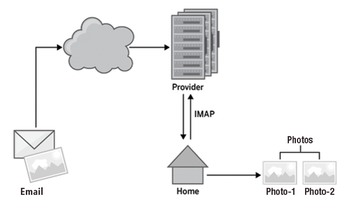Fetch email and extract photos
Programming Snapshot – Go Mail Client

© Lead Image © Tatiana Venkova, 123RF.com
In this month's column, Mike Schilli writes a special mail client in Go and delves into the depths of the IMAP protocol in order to archive photos from incoming emails.
Popular email clients such as Thunderbird or Microsoft Outlook make it very easy to automatically filter and forward incoming messages. I recently had the idea of sending freshly taken photos to my account by email, from where my desktop computer would automatically retrieve them at regular intervals, extract the photos from the email body, and proceed to archive them (Figure 1). How difficult would it be to fetch emails from the provider with a DIY Go program and extract the photos embedded in MIME format in order to store them on my hard disk? Luckily, Go libraries make quick work of such problems!
Transport Logistics
In order for turnkey email clients to gain access to your choice of provider's mail server, they require three parameters: the IMAP server including the port, the username, and the password. Besides this, you are always asked for the SMTP server and port, possibly along with any other credentials you might have there. The reason for this is that two completely different technologies are used to collect and send email, and they usually run on different servers.
[...]
Buy this article as PDF
(incl. VAT)
Buy Linux Magazine
Subscribe to our Linux Newsletters
Find Linux and Open Source Jobs
Subscribe to our ADMIN Newsletters
Support Our Work
Linux Magazine content is made possible with support from readers like you. Please consider contributing when you’ve found an article to be beneficial.

News
-
Parrot OS Switches to KDE Plasma Desktop
Yet another distro is making the move to the KDE Plasma desktop.
-
TUXEDO Announces Gemini 17
TUXEDO Computers has released the fourth generation of its Gemini laptop with plenty of updates.
-
Two New Distros Adopt Enlightenment
MX Moksha and AV Linux 25 join ranks with Bodhi Linux and embrace the Enlightenment desktop.
-
Solus Linux 4.8 Removes Python 2
Solus Linux 4.8 has been released with the latest Linux kernel, updated desktops, and a key removal.
-
Zorin OS 18 Hits over a Million Downloads
If you doubt Linux isn't gaining popularity, you only have to look at Zorin OS's download numbers.
-
TUXEDO Computers Scraps Snapdragon X1E-Based Laptop
Due to issues with a Snapdragon CPU, TUXEDO Computers has cancelled its plans to release a laptop based on this elite hardware.
-
Debian Unleashes Debian Libre Live
Debian Libre Live keeps your machine free of proprietary software.
-
Valve Announces Pending Release of Steam Machine
Shout it to the heavens: Steam Machine, powered by Linux, is set to arrive in 2026.
-
Happy Birthday, ADMIN Magazine!
ADMIN is celebrating its 15th anniversary with issue #90.
-
Another Linux Malware Discovered
Russian hackers use Hyper-V to hide malware within Linux virtual machines.


